Most of us have bogey birds – certain species that for one reason or another elude us for years. Forty years ago my bogey was the Bohemian Waxwing, and by 1986 I was sufficiently keen to see one that I was prepared to resort to twitching. I was told of a small flock feeding on a cotoneaster tree in a cul-de-sac in Ipswich, a town 80 miles north of where I lived at the time. A friend and I drove in search of them, and we duly found the right road, even the right tree, but there wasn’t a Waxwing to be seen. I get easily bored, so after an hour’s unfruitful wait we went off looking for ducks at Benacre Broad, a coastal lagoon. Here we bumped into a fellow birder who told us of a Waxwing he had just seen in Lowestoft, 10 miles to the north, so off we went again. We eventually located our quarry sitting on a television aerial in the back streets of one of the less attractive parts of the town.
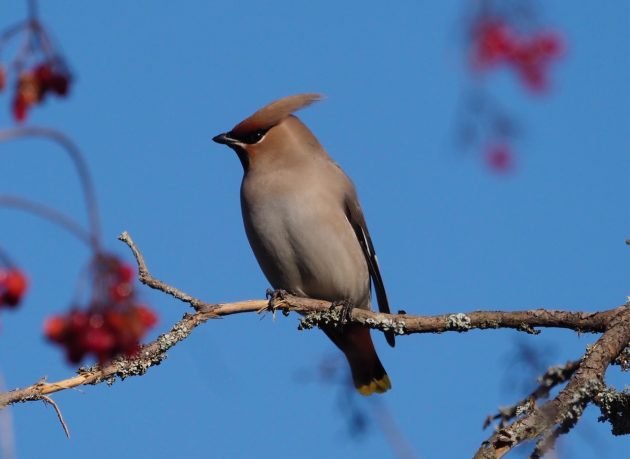
Worth twitching for: a Bohemian Waxwing. This bird was photographed in Estonia
As first views go, it wasn’t the greatest. I’ve seen Waxwings many times since, and that Lowestoft bird was without doubt the least pleasing. That’s one of the reasons why I rarely twitch, as it’s so much more satisfying to not only find your own birds, but see them in their right habitat. Watching Waxwings hawking for flies in the arctic forests of Finland is a totally different experience to seeing one perched forlornly on a TV aerial.
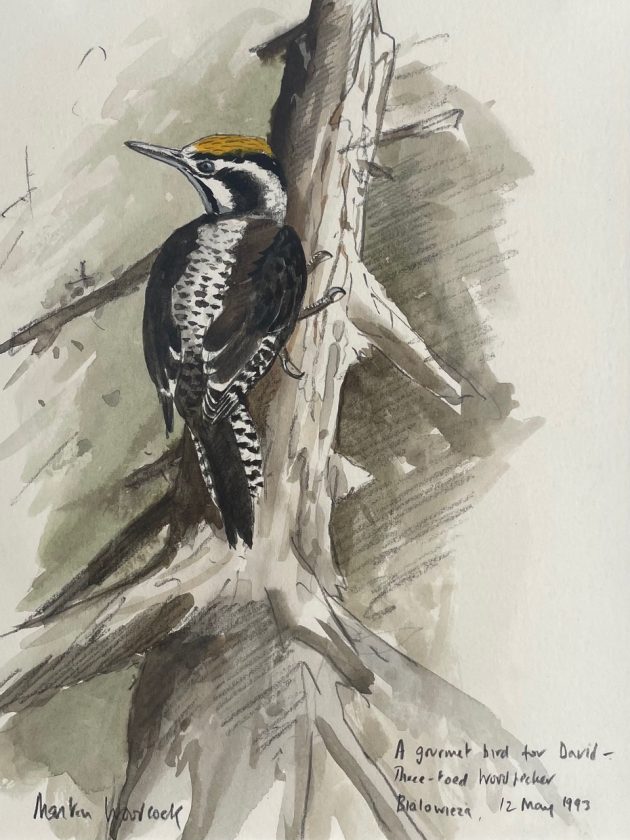
The Waxwing was by no means the last of my European bogies. I never had any problems with White-backed Woodpecker, a species that eludes many people, and by the early 90s I had have seen them in the French Pyrenees (where they are rare and elusive), the Bavarian Alps and Poland. However, Three-toed Woodpecker was another matter, and despite several visits to forests where they occurred, they continued to elude me. I finally saw my first in Poland’s Bialowieza Forest in May 1993. I was leading a birdwatching holiday at the time, and was the only person carrying a telescope. I quickly set the scope up on the bird, and all 10 people in my group enjoyed a great look. I waited patiently, but when my turn finally came, the bird flew off. There was compensation, though. Bird-artist Martin Woodcock was in my party, and he later presented me with a delightful watercolour of that bird which continues to give me great pleasure (above).
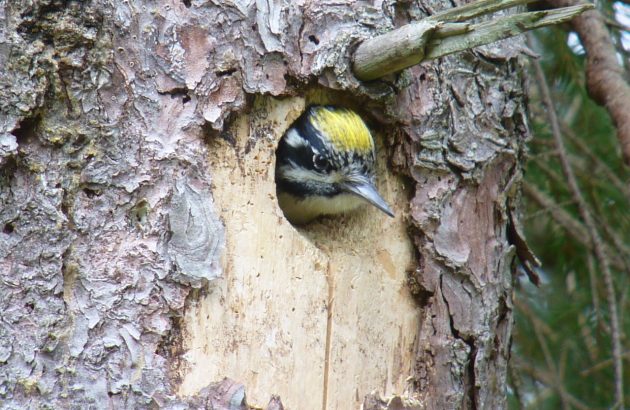
A Three-toed Woodpecker photographed at its nest in Poland’s Bialowieza Forest
I’ve now watched these attractive woodpeckers in Sweden, Finland and Estonia, and can confirm that they are hard to see because they are small, quiet and unobtrusive. In January 2006 I was with a Norwegian pheasant shooting party in central Sweden. The pheasants were few and far between, and we were hunting for them in mixed pine and birch woods. Suddenly I saw a movement on a tree just in front of me and sure enough it was a Three-toed. It was remarkably tame, and I managed to call my wife over to see it before it moved away.
Finding birds in the taiga forests of northern Europe and Siberia is hard work, as the birds are thin on the ground, the area of potential habitat huge. Thus it wasn’t really surprising that my last significant European bogey bird lives in this wilderness. In April 2006 I led a holiday on behalf of the Hawk and Owl Trust to northern Finland. It was a late spring, and in the forests around Kuusamo, just north of the Arctic Circle, the snow was still 6ft deep. Birds were few, but those we did find were certainly worth seeing. Highlights were Great Grey, Hawk and Pygmy Owls, while seeing my first Willow Grouse in pure-white winter plumage was a memorable experience. Siberian Jays and Siberian Tits were exciting, but I had seen them before. What I hadn’t seen, but had missed several times, was Pine Grosbeak.
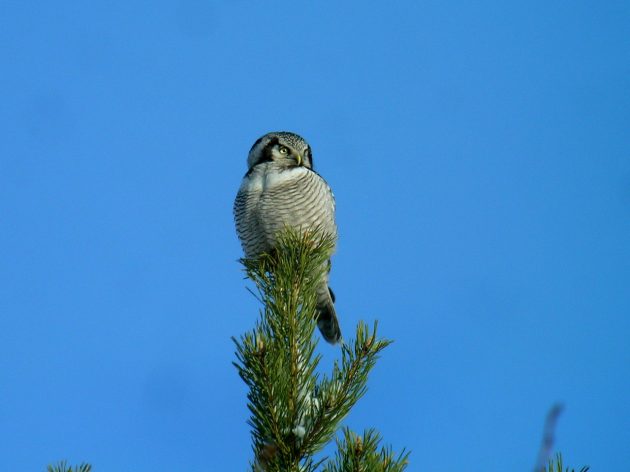
A Finnish Hawk Owl, one of the most exciting birds of the taiga forests
Our local guide. Markku, took us to a hilly area some way west of Kuusamo, within the Arctic Circle. He assured us that there was a good chance of seeing Grosbeaks here, but the omens hardly seemed good. It was cold, around -10degC, the sky dark grey, it would have been quite dark but for the light reflected back from the snow. There was that uncanny silence you only find in areas of real wilderness. No cars, no aeroplanes, no people, nothing, not even birds.
My diary records that “the snow was very deep, the trees crowned with heavy white caps of frozen snow, but there was not a sign of life. Because we were reasonably high there was a grand vista spread out below us. Grosbeaks don’t, apparently, respond to tapes of their calls, so Markku was using a Pygmy Owl tape instead. Frustratingly, there wasn’t a response to the owl at the stops we made, and the chances of finding a Grosbeak seemed increasingly unlikely. Then, amazingly, two birds were seen flying and yes, they were Grosbeaks, so we all tumbled out of the mini bus into the cold snow. One Grosbeak perched on the top of a spruce tree about 100 yards away where we were able to scope it, and then it flew closer, landing again. It was a first-year male, and it sang for us from the top of another spruce, pausing to feed at the same time as it nimbly bent down to grab a bud. It flew, but then a pair showed well, including a beautiful full-plumaged male. This was my first lifer in Europe for years.” It was also a highly satisfying moment: there aren’t many people who have seen Pine Grosbeaks in the forests away from feeders.
Ironically, only three months later I found myself looking at a Pine Grosbeak again, but this time in a friend’s garden in Essex. He had emailed me four rather poor pictures of the bird that had appeared in his garden the night before. He thought it was a crossbill and wondered whether they were normally so tame. I gave the pictures a quick glance, and noted one that showed the bird had a double wing-bar. Two-barred crossbill? It was worth going to see.
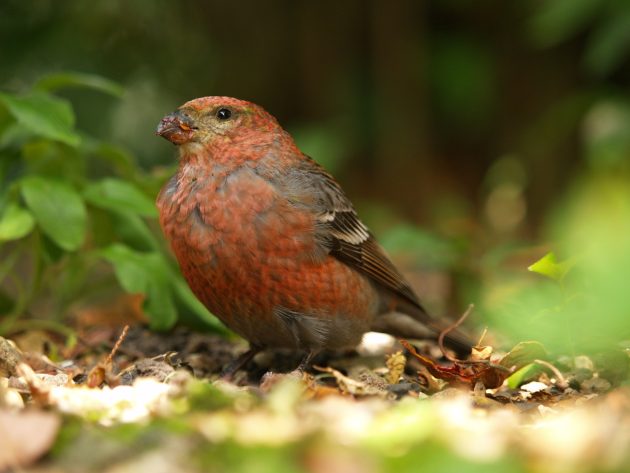
The escaped Pine Grosbeak. It was a colour-fed female
I phoned my pal, who confirmed that the bird was still in his garden, so I drove down to view it. It wasn’t to be seen when I first arrived, but it eventually flew in and started feeding, allowing me to take numerous photographs. It was ridiculously tamer. No, it wasn’t a Two-barred Crossbill, but a Pine Grosbeak, an extremely rare bird in Britain, with fewer than a dozen records. Later that day I sent photographs of it to BirdGuides (a bird-news site). I explained that my friend’s garden was unsuitable for a twitch, but I did happen to mention the garden was not far from the town of Chipping Ongar.
At 7.30 on the Saturday morning, fewer than 36 hours after I had photographed the Grosbeak, I had a call from my friend. “The twitchers have arrived” he said. “There’s at least 30 of them, walking up and down the lane with telescopes.” It later transpired that I had inadvertently given away sufficient clues for the twitchers to trace my friend’s house. By mid morning scores more had joined them. The local farmer opened up a field for parking at £5 a go, some enterprising small girls baked cakes and sold them to the twitchers, while in the afternoon a hot-dog stall and ice-cream van also arrived. Ironically, despite so many people looking, no-one saw the bird.
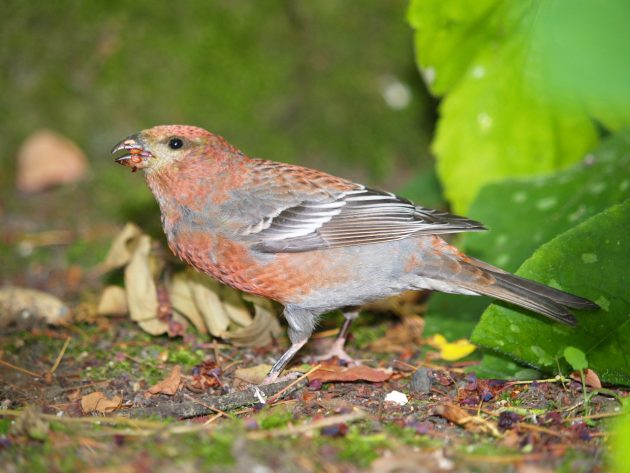
Pine Grosbeaks are extremely rare in Britain, with fewer than a dozen records. This one, photographed in Essex, was a captive-bred bird that had escaped from an aviary
It was relocated a few days later some miles away in Hertfordshire, where a mass twitch took place, and several hundred people managed to see it. Meanwhile I had set out to trace the bird’s origin, writing to the weekly paper Cage & Aviary Birds to try and discover if anyone was missing a male Pine Grosbeak. A day after the paper came out I had an e-mail from an anonymous birdkeeper who lived close to Chipping Ongar, Yes, he had lost a Grosbeak. It was a colour-fed female he’d bred the year before. He sent me pictures of her in the nest as proof.
The result: lots of disappointed twitchers, who had to scrub Pine Grosbeak from their lifelists. There was also some embarrassment in that the so-called experts who had seen the bird had pronounced this to be a first-year male, while the possibility of a colour-fed female hadn’t even been considered. The moral to this story is that if you want to see a real Pine Grosbeak, go to Finland. You will certainly have to work hard and you might get frozen feet, but it will be well worth it when you finally see your quarry.
Source link


